As a general rule, the most successful man in life is the man who has the best information
Chile, the best place to be
Access to raw materials at competitive prices has become essential to the functioning of all industrialized economies. As we modernize, developed and developing countries will continue to place extraordinary demands on our ability to access and distribute the planet’s natural resources.
A sustainable, and secure,
supply of raw materials is going to become the number one priority for all countries. Increasingly we are going to see countries ensuring their own industries have first rights of access to internally produced commodities and they will look for such privileged access from other countries.
We see this right now in the protectionism of the United States, which has realized after many years of government inaction that it no longer has a local supply of important metals to feed its growing economy. Security of supply also underpins the entire intermodal transportation system - ships, railways and trucks - all carrying containerized goods that rely on “just in time” supply chains. Imagine the grocery industry or auto-parts manufacturers having to wait for shipments before moving on to the next point of distribution. The whole system would fall apart. Most industries cannot function without security of supply.
However the “
metallurgical Achilles heel,” of the United States is its dependence on foreign imports of strategic metals. Trump has to be credited for being the first President in decades to recognize this. In December Trump signed an executive order to reduce dependency on 23 minerals deemed critical to national security. “The comprehensive order aims to identify new sources of critical minerals, ensure miners and producers have access to the best data, and streamline the leasing and permitting process to expedite production, reprocessing and recycling of minerals at all levels of the supply chain,” said a statement from the White House.
Included on this list is lithium - the key ingredient in lithium-ion batteries used in electric vehicles as well as cell phones, power tools and many other electronic devices. EV batteries also contain nickel, cobalt, and graphite. The United States currently imports most of the lithium that it consumes – with import reliance today pegged at over 70%. Due to junior lithium explorers having a hard time raising funds in North America, many are heading to Asia to sign agreements with battery-makers.
An example is Japan’s SoftBank which invested $100 million into Nemaska Lithium’s mine and electrochemical plant in northern Quebec, Canada. SoftBank owns a 15% stake in Uber and wants to convert its taxis in China and India to electric vehicles.
The increasing trend, almost all the major moves being made to lock up lithium supplies is not in North America; it’s in the South American salars (evaporated salt lakes), where three-quarters of the world’s lithium is produced. And with 50% of the world’s lithium resources in Chile, as well as the country being the lowest cost producer, Chile, if you’re a junior resource company in the lithium space, is the place to own lithium projects.
 Lithium Chile
Lithium Chile
Lithium Chile (TSX-V:LITH, OTC-QB:LTMCF) is one such company with excellent potential for partnerships and offtake agreements from its sprawling collection of properties in Chile that it managed to pick up at rock-bottom prices.
Lithium Chile’s Chief Geologist Terry Walker staked the highly prospective land blocks for not much more than $3 a hectare
.
The small-cap lithium junior holds 152,900 hectares across 14 salars and one “laguna” (lagoon in Spanish), surrounding the world’s most important lithium reserves in the Salar de Atacama.
LITH’s land package (video) is the largest privately-owned lithium amassment in Chile. Now, prospective lithium blocks in Chile are going for $1,000 a hectare; not only that, the low-hanging fruit is gone. To assemble the same land package at today’s prices would cost over $150 million.


Two of The Big Three lithium producers - US-based Albemarle and SQM, Chile’s largest lithium producer - control nearby ground. Moreover, Chile has become recognized as an excellent mining country, with a low risk of resource nationalism (resource nationalism is the tendency of people and governments to assert control, for strategic
and economic reasons, over natural resources located on their territory), a new mining code, and clear permitting rules - all major pluses for mining and exploration companies hoping to do business there. Some other key points about LITH:
The company has the grades and the size that would interest a potential acquirer or partner. Surface and auger sampling at its four main prospects returned grades ranging from 580 milligrams per liter (mg/l) at Salar de Turi, to 1,410 mg/l at Salar de Coipasa, found a meter below surface. Surface and near-surface sample grades on the four properties were north of 1,000 mg/l.
In lithium brine mining, size is important because you need large evaporation ponds. Anything less than 3,000 hectares is too small. Lithium Chile’s Coipas and Helados salars size up at a respective 11,000 and 30,000 hectares - making them suitable for building a lithium production facility in the future.
Lithium Chile has attempted to control the majority of the land in their most prospective targets. For example they control over 70% of the Salar de Coipasa. Majority ownership in the salars is key, in ensuring that they don’t get diluted by competitors.
Most of the samples taken by Lithium Chile have been taken at or near surface. This is important because the deeper the target, the more brine needs to be pumped to the evaporation pond - adding costs and time.
Finally, most of the samples LITH has taken so far are running at around a 4:1 ratio of lithium brine to magnesium. This is significantly lower than brine-magnesium ratios in Argentina, which run between 5:1 and 10:1. Magnesium, a contaminant, has to be removed by adding slaked lime to the brine, increasing costs.
Speaking of Argentina, Lithium Chile has the advantage of being in a country with significantly higher grades and reserves than its neighbor, due to geography. The Salar de Atacama has just the right amount of heat, wind and lack of rain to ensure high evaporation rates, making it the ideal location for lithium mining.
“Lithium brine production in Chile is the cheapest in the world and it’s less than half of our nearest competitors. Brine production here is in the order of $1,500-$1,800 per ton, while hard rock mining costs $5,000 per ton,” Terry Walker, VP Exploration and Chief Geologist, stated in a news release.
Argentina is also considered to be a risky place for mining companies to do business. Despite the end of 12 years of leftist rule, a shaky economy and a lack of regulatory clarity has meant the mining industry and its investors are still hesitant.
Rising EV output fueling battery demand
Asia and particularly China is going after lithium, and is years ahead of North America in terms of EV penetration and battery supply chains. Last year China sold about 700,000 electric cars, 200,000 more than 2016. Government subsidies to EVs have been reduced by 20%. Beijing sees EVs as the key to unlocking the
pollution dilemma that has plagued its car-choked cities, governments across the globe see EV’s as a major weapon in the fight against
global warming. China represents over a quarter of the global EV market, and will own 40% by 2040 according to the International Energy Agency (IEA). The country has signed lithium offtake agreements with mines in Australia, Canada and Africa, and despite Tianqi Lithium – which owns 51% of Talison’s Greenbushes mine in Australia, the largest hard rock lithium mine in the world – being recently denied a 32% ownership stake in SQM, China isn't giving up.
Other Asian companies, such as Japan’s Panasonic and Korean conglomerate Samsung, are also looking to ink deals. Lithium X Energy accepted a buyout offer from NextView, a Chinese investor consortium, for its flagship lithium property in Argentina. NextView also acquired a 20% stake in Bacanora Minerals' Sonora lithium project in Mexico.
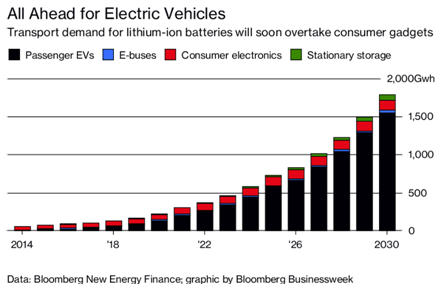
China and India are both going to 100% electric vehicles. Every major car manufacturer has electric models. Volvo has even promised to phase out internal combustion engines (ICEs) from 2019. France has vowed to end the sale of gasoline and diesel vehicles by 2040; the UK quickly followed suit. Almost a third of cars sold in Norway in 2016 were electric and Germany could outpace its neighbors as Volkswagen aims to become a leader in both EVs and automated vehicles. EVs surpassed 2 million units in 2016 and Bloomberg New Energy Finance predicts they will make up an astounding 54% of new car sales by 2040.
In 2016, Chinese carmakers sold 28.03 million cars. If China follows through on its promise to go 100% electric that’s a minimum 28.03 million lithium-ion battery packs for EVs per year. Last year China sold 777,000 units of battery-powered, plug-in hybrids, and fuel-cell vehicles, and could surpass a million this year according to estimates from the China Association of Automobile Manufacturers.
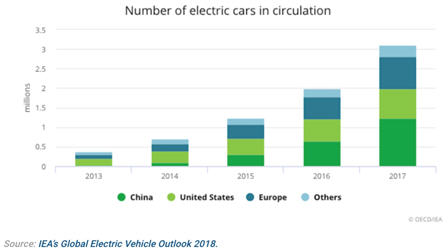
Add in the UK’s 2.7 million car sales in 2016 and France’s 2 million car sales in 2016. That’s 32.73 million electric vehicles all requiring lithium-ion battery packs, without counting electric buses (a big deal in China, and going to be in India as well) or annual growth rates in auto sales. One Tesla car battery uses 45 kg or 100 pounds of lithium carbonate.
The IEA said recently that it
expects the number of EVs to more than triple by the end of the decade, from 3.7 million last year to 13 million in 2020. According to the organization the biggest adopters will be Europe and China, due to credits and subsidies provided by the Chinese government, and tighter fuel emissions standards plus higher fuel taxes in Europe.
All of this, of course, is good news for miners of lithium, nickel, cobalt and
copper, which are essential to the manufacture of electric vehicles. The IEA says demand for these metals could rise 10-fold, which is having an effect on prices. Nickel, copper and cobalt have all been enjoying great runs. The price of lithium carbonate equivalent (LCE) has risen 25% compared to 2017, and is now trading around US$16,000 per tonne.
VW’s 40-billion euro commitment
One of the most telling signs of the tectonic shift from gas-powered vehicles to EVs was the
$40-billion-euro deal that Volkswagen inked with major EV battery suppliers. 40 billion euros. That’s almost as much as Tesla’s market cap in dollars ($46 billion vs $50B). According to Fortune, Volkswagen is planning to sell up to 3 million EVs a year. The German company dwarfs Tesla’s production by a long shot. It makes more cars in four days than Tesla does in a year. In fact VW is so gung-ho on EVs, it’s planning to establish battery cells in Europe to satisfy emerging demand.
As mentioned Japan’s SoftBank invested $100 million into Nemaska Lithium’s mine in Quebec. Nemaska also has an offtake agreement with Northvolt, which is aiming to have Europe’s largest battery factory. Under the deal announced in April, Northvolt agreed to purchase between 3,500 and 5,000 tonnes of lithium hydroxide, for five years, from Nemaska’s Shawinigan plant.
These multi-million and multi-billion-dollar deals show that the world’s largest car and battery companies – that big business, governments and consumers get it, that they are all serious about combating pollution and
climate change, the electrification of our transportation system is underway. And it all comes down to security of supply of lithium because it is all about the batteries. As automakers cut deals for large scale battery production they also see
massive potential in the residential/commercial energy storage business through the lithium battery packs they’re already building. But without batteries, read that as lithium, they’re dead in the water because without battery materials, their production lines grind to a halt.
China’s dominance
Most North Americans consider Tesla to be the market leader in electric vehicles with its Gigafactory in Nevada but the real action is taking place in China. Who is the largest EV battery maker in the world? If you said Panasonic, which supplies Tesla, you’d be wrong. It’s actually Contemporary Amperex Technology Ltd. (CATL), a Chinese company.

Among its clients are Volkswagen, BMW, Hyundai Motor and Nissan. CATL is trying to get financing to build a new 24-gigawatt-hour factory in its home province of Fujian, and is supplying its cells to a number of number of major automakers in China who are rolling out new EV models including Toyota’s ix4, a rebranded EV being developed by its Chinese partner, Guangzhou Automobile Group, a plug-in version of Hyundai’s Sonata, and BMW’s 530Le sedan. CATL opened an office in Yokohama, Japan, and is looking to build plants in Europe.
Adding the plant in Fujian would mean that CATL surpasses the output of Tesla’s Gigafactory in Nevada, BYD Co., backed by Warren Buffet, and South Korea’s LG Chem Ltd., making it the world’s largest EV battery supplier, according to Bloomberg New Energy Finance. CATL already supplies batteries for BAIC Motor Corp, the biggest EV seller in in China, and Zhengzhou Yutong Group, the world’s largest bus maker,
states Bloomberg.
Financing the $1.3 billion factory is to come from an
IPO which CATL recently had to more than halve. It planned to raise $2 billion by selling a 10% stake, valuing the company at $20 billion, but the IPO price was reduced to 25.14 yuan a share, valuing the company at just $8.5 billion. The lessened IPO value was a result of a decline in CATL’s margins due to China’s decision to reduce subsidies for electric vehicle purchases.

Beijing has also put a cap on price-earnings ratios in IPOs in order to curb speculation, which factored into the reduced IPO price (valuations can’t be more than 23 times profit).
The scaled-back IPO however isn’t expected to dent the building of new battery plants. In fact, Simon Moores, managing director of Benchmark Intelligence, says
the world is in the midst of a “global battery arms race” with a massive spike in gigafactories coming in the next five years.
Benchmark Intelligence forecasts capacity at gigafactories to increase from 112 gigawatt hours last year to 441.5 GWh in 2023. Tellingly, the London-based research firm notes that prices for lithium-ion battery cells have fallen around 16% annually since 2014, putting the technology almost on par with internal combustion engines.

Also electric vehicles (EVs) have far fewer moving parts than Internal Combustion Engine (ICE) gasoline-powered cars - they don't have mufflers, gas tanks, catalytic converters or ignition systems, there’s also never an oil change or tune-up to worry about getting done.

A lot of the new growth will be in China. Of that 441GWh, about 130GWh are expected to be built in the world’s second largest economy - which is three times the rest of the world combined.
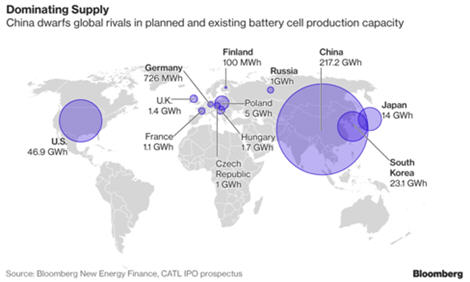 Chile, the best place to be
Chile, the best place to be
So where all these
new gigafactories going to source their lithium hydroxide and lithium carbonate? It’s likely that a great deal of it will come from the lithium salars in Chile, which is the lowest-cost jurisdiction for lithium mining and home to 52% of global supply.
As mentioned Asian firms are already active in South American lithium salars. Eight years ago
Lithium One formed a joint venture with Korea Resources Corporation to develop its Sal de Vida lithium brine project in Argentina.
“Effectively, Strydom notes, the “middle man”, who will be adding value to the mineral and end product, will be sitting in a bottleneck squeeze as the raw material prices will be increasing, while product prices are decreasing.
This means that margins are coming under threat, he warned, adding that the market tendency has been to see end product manufacturers positioning themselves in securing mineral resources through capital investments.” Battery metals industry dependent on ‘flavour of the month,’ miningweekly.com
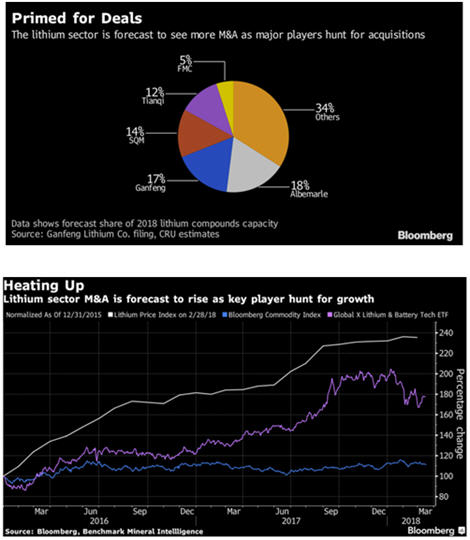
China has a stake in Argentina’s Cauchari-Olaroz lithium project - a 50/50 JV between SQM and Lithium Americas. Having financed $172 million,
Jianxi Ganfeng Lithium is now Lithium America’s largest shareholder with a 19.7% stake. Chinese and South Korean companies are among the bidders to construct the giant Salar de Uyuni lithium carbonate plant in Bolivia - which currently produces no lithium.
It’s been reported that Chinese battery manufacturers expect to buy their lithium from Chinese-owned firms. And they’ll want to get in on the ground floor of exploration companies with promising projects that can produce at the scale they need to supply their automaker customers. The same thing can be said of battery companies from other countries, including North America, but non-Chinese battery-cos have a lot of catching up to do.
Conclusion
Carbon emissions from burning fossil fuels keep climbing.
Governments around the world are looking at ways to reduce carbon emissions. Two ways we can reduce CO2 emissions are to stop burning fossil fuels to power our energy grid and by adopting electric vehicles for the transportation of people and goods.
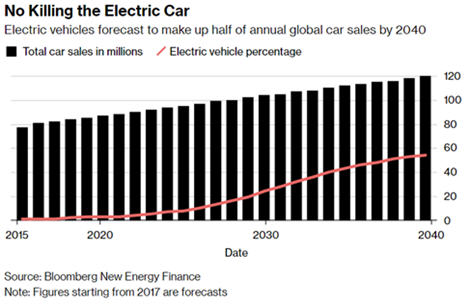
lith
The real story behind all electric vehicles is that they are totally emission free. Electric vehicles are going to become very popular.
Lithium Chile is uniquely positioned in the battery-metal supply chain to be exactly in the right place at the right time. The company has a highly prospective land package in the Salar de Atacama - surrounded by experienced producers SQM and Albemarle - making it an excellent candidate for a battery-maker looking to ink a supply deal with a reliable producer in the lowest-cost lithium mining jurisdiction in the world. With electric vehicle demand expected to remain robust, and supply limited due to the difficulties in processing lithium and the high costs of hard-rock lithium mining, prices should keep rising. This is good news for prospective lithium miners like Lithium Chile who are not only likely to receive a good price for their product, but have a captive market in EV suppliers who are eager to lock up long-term contracts. Move over gas-guzzling cars, the EV era is here, and Lithium Chile is poised to play an important part in supplying the metal which has been called “the new gasoline.”
For all of these reasons, I’ve got LITH on my radar screen.
Richard (Rick) Mills
aheadoftheherd.com
Just read, or participate in if you wish, our free
Investors forums.
Ahead of the Herd is now on
Twitter.
Newsletter Archives.
Legal Notice / Disclaimer
This document is not and should not be construed as an offer to sell or the solicitation of an offer to purchase or subscribe for any investment.
Richard Mills has based this document on information obtained from sources he believes to be reliable but which has not been independently verified.
Richard Mills makes no guarantee, representation or warranty and accepts no responsibility or liability as to its accuracy or completeness. Expressions of opinion are those of Richard Mills only and are subject to change without notice. Richard Mills assumes no warranty, liability or guarantee for the current relevance, correctness or completeness of any information provided within this Report and will not be held liable for the consequence of reliance upon any opinion or statement contained herein or any omission.
Furthermore, I, Richard Mills, assume no liability for any direct or indirect loss or damage or, in particular, for lost profit, which you may incur as a result of the use and existence of the information provided within this Report.
Richard does not own shares of Lithium Chile (TSX.V:LITH). LITH is a paid sponsor of Richard’s site, aheadoftheherd.com